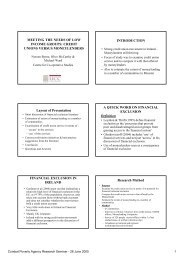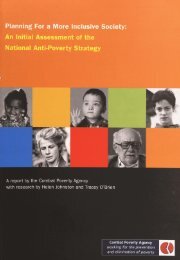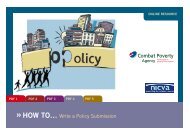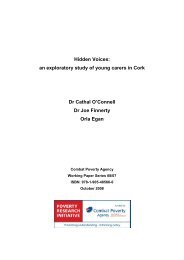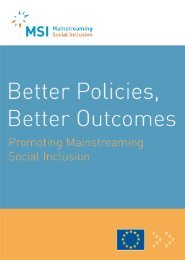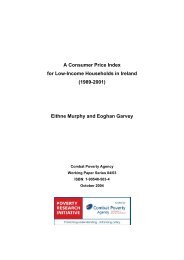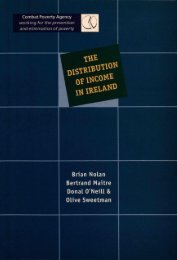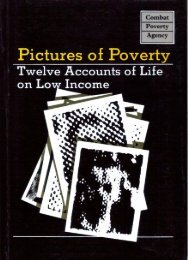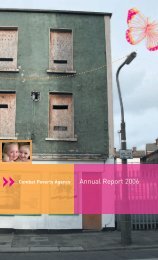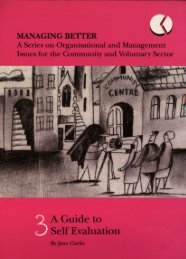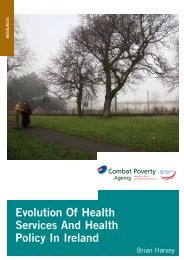Women and Poverty (1989) - Combat Poverty Agency
Women and Poverty (1989) - Combat Poverty Agency
Women and Poverty (1989) - Combat Poverty Agency
Create successful ePaper yourself
Turn your PDF publications into a flip-book with our unique Google optimized e-Paper software.
......<br />
<strong>Women</strong> <strong>and</strong> <strong>Poverty</strong> .<br />
In spit~ of p-owing. awareI.1ess of the existence of poverty,<br />
very httle mformation eXists about poverty among Irish<br />
i; women. We can estimate the numbers of women living below<br />
'I a poverty line but we have little comprehensive <strong>and</strong><br />
accessibl.e information. on what life is like for women living<br />
~>n 10':" 1I,1comes. Until, now the~ has not been a specific<br />
mvestigation of women s poverty m Irel<strong>and</strong>. At best, women<br />
have been an addendum to research focusing mainlyon men<br />
or, m~re C?ften, in~ormation is not analysed by sex. The huge<br />
gaps. ~n mfo~allon about poverty among Irish women<br />
precipitated thiS book. Without adequate information <strong>and</strong><br />
analysis, new <strong>and</strong> effective policies to address women's<br />
.,<br />
:i poverty are unlikely to be developed. .' .<br />
:1 .Changes now taking place in Irel<strong>and</strong> put women at greater<br />
~sk of.pove~. They Include population changes ~ such as<br />
"<br />
Increasmg mantal breakdown, more children being reared by<br />
one parc::nt families <strong>and</strong> growing numbers of elderly women.<br />
EconOmiC changes are also key, having .led to very high<br />
?!1employ~ent <strong>and</strong> a ~wing number oflow paid jobs. There<br />
IS al~o an m,creased rel~ance on women's unpaid work, as<br />
pubhc spending on servIces, especially health services is cut<br />
back. In many countries there is an emerging pheno~enon<br />
known as the feminisation of poverty where. women are<br />
forming an increasing proponion of the world's poor <strong>and</strong> are<br />
more visible in their poverty than ever before. In the United<br />
States of America, it is estimated that two out of every three<br />
poor adults are women; in Britain 40% of all households<br />
headed by a woman are poor.(4) Many other countries have<br />
. alS? expe~enced a growth in female poverty - usually because<br />
of Increasmg numbers of one-parent families <strong>and</strong> continued<br />
low· wages for women at a time when their economic·<br />
responsibilities have never been higher.<br />
Perceptions of<strong>Poverty</strong><br />
The true extent of poverty is still not widely accepted in this<br />
co~nnr. Yet t1?e fac~s are a~ai~able to show that poor people<br />
~XISt Side by SIde With a rnaJonty who have a fairly adequate,<br />
if not a comfortable, st<strong>and</strong>ard of living <strong>and</strong> a minority who<br />
'it<br />
'It<br />
are very.well off. One hears many excuses: there is no 'real'<br />
"I' poverty In Irel<strong>and</strong> today compared with the 1930s<strong>and</strong> 1940s;<br />
,I<br />
H !:<br />
6<br />
no one needs to be poor now with social welfare; people are<br />
poor through some fault or failing of their own. Each of these<br />
statements is rooted in particular beliefs. The first in the belief<br />
that there is only a single type of poverty, one that involves<br />
absolute destitution <strong>and</strong> deprivation. The second belief is that<br />
the social welfare system. eliminates poverty;.the third that<br />
people have equal access to resources <strong>and</strong> opportunities <strong>and</strong><br />
therefore everybody has the possibility of getting on. Each of<br />
these is false. . ,.' " .<br />
. <strong>Poverty</strong> is not only about basic physical survival but must be<br />
measured <strong>and</strong> understood in the context of the st<strong>and</strong>ards of<br />
living <strong>and</strong> lifestyles of the population as a whole. So, being<br />
poor today is very different from the poverty of earlier times <br />
people donot have to be destitute to be poor now. The second<br />
argument - that social welfare eliminates poverty - is also<br />
untrue; Ending poverty is ·not even a stated aim of social<br />
welfare; its main purpose is to provide a subsis.tence inco~e<br />
for those who cannot keep themselves, that IS, to sustam<br />
people at a basic level. With regard to the argu~~nt that.it is<br />
the poor's own fault, resources <strong>and</strong> opportumnesare not<br />
distributed equally: some people have more than others <strong>and</strong><br />
easier access to education to begin with, <strong>and</strong> therefore. are<br />
better placed to prosper <strong>and</strong> advance themselves.<br />
What is <strong>Poverty</strong>?' .' ." '. .<br />
Even though it is a widely used term, poverty is a difficult<br />
concept to define <strong>and</strong> underst<strong>and</strong>. Yet it is important to arrive<br />
at an acceptable definition of poverty, not, just for its own<br />
sake but also because doing so.helps IUS to identify the<br />
. measures necessary to eliminate it. ;" !. .<br />
<strong>Poverty</strong> is mainly associated in the public mind with m~ney<br />
<strong>and</strong> material well-being. One o[the mos~ enduring questlons<br />
about poverty is whether it should be n:eated, as abso.lute .or<br />
relative. Treating poverty as absolute IS to equate It WIth<br />
physical survival, ie enough money to provide sufficient food,<br />
clothing <strong>and</strong> shelter just to survive. Talking with people who<br />
are themselves poor shows how this view of poverty fails to<br />
take into account people's other needs (social, emotional,<br />
political <strong>and</strong> culttlral) <strong>and</strong> that ~here is mu~h more to life t~an<br />
having enough food <strong>and</strong> clothmg.to survive. Yet the nollon<br />
7




